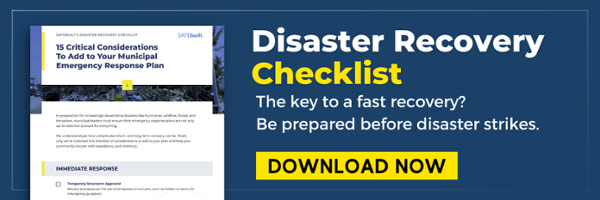Disaster can strike in all forms, especially when we least expect it. Fires, wind, floods, environmental contamination, terror threats, drought, deep freeze — and that’s just a few of the common emergency events we see annually.
Our response to disaster events (both personally and corporately) is demanding. It’s also critical to recovery outcomes in our communities. Community leaders have a duty to lead by example and be prepared to manage their responsibilities in an effective and professional manner when they are called to serve.
Let’s explore what that looks like.
How to prepare your community for a disaster
While it’s easy to jump into addressing the impact on your community, take a step back and consider what first needs to come together to allow you to focus on the tasks at hand.
Step 1 — Prepare at Home
Disasters begin and end at home. Home lives are disrupted, and community leaders are expected to have the right people, in the right place, and execute the right plans to help the community start getting back to normal as quickly as possible.
To be an effective part of recovery, we must prepare ourselves and our families so we can be available to perform our jobs during and after a disaster.
First things first, are you and your home ready to survive without water and electrical service for at least three days? Do you have necessary medications, first aid, fuel, batteries and lamps, communication strategies, and pet supplies at home for when disaster strikes?
Your family emergency preparedness plan should include:
- Identifying the hazards that could impact your family
- Identifying the safe areas in your home for each type of potential disaster
- Determining escape routes and places to meet in an emergency
- Teaching your children how to utilize 911
- Preparing a portable emergency kit
When you can trust that your home life is situated for an emergency, you can better serve your community during that time and in the moments after. If you aren’t sure where to begin with your preparedness plan,we've put together several resources, including this helpful planning guide.
Step 2 — Prepare Your Community
In accordance with the Federal Emergency Management Agency (FEMA), here are 10 recommendations for preparing your community for a potential future emergency.
- Know the risks — Know what risks are most likely to occur and impact your community, and identify what impact those situations may have on your residents and your organization.
- Reduce your risk — Before an emergency occurs, take the time to protect your physical and technological space from potential threats.
- Safeguard important information — Implement secure networks and data storage and make sure your data is backed up in more than one place.
- Create a communications plan — Map out how you will communicate with and provide updates to families, clients, news outlets, and the rest of your community.
- Know what your people need — Know what needs will need to be met in the event of an emergency.
- Cross-train your people — Make sure that you are able to backfill roles in the event that your designated people cannot assume their responsibilities.
- Make formal plans — For example, if you plan to elect an emergency manager in the case of a disaster, document your plans ahead of time so that there is a clear path forward.
- Outline essential activities — Know what it takes to keep your organization running in the event that your physical space is damaged or inaccessible. This includes how you will pay your employees and where you will continue performing your work.
- Take stock of the supply chain — Find ways to get the supplies you depend on, or identify alternative suppliers that can provide you with what you need should your supply chain be disrupted.
- Test your plans and update — You don’t want to test your luck when it comes to an emergency. Before you need to execute your plan, run tests frequently to make sure that everything you’ll need is truly in place.
Need help preparing for (or recovering from) an emergency?
SAFEbuilt can help. Our experts can help with emergency preparedness, as well as reducing risks and safeguarding your infrastructure.
Already working through the aftermath of a community emergency? Our experts can also step in to assist with rapid recovery and continuity for communities that have experienced recent emergencies, allowing you to focus on long-term recovery.
Get in touch with a community services expert to learn more.



